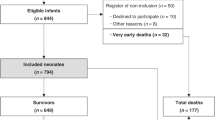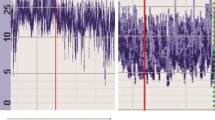Abstract
Objective
To study the association between perinatal sentinel events (PSE) and brain MRI/neurodevelopmental outcomes in neonates with hypoxic-ischemic encephalopathy (HIE) receiving therapeutic hypothermia (TH).
Design
This is a retrospective single-center study. Data collection included perinatal history, brain MRI, and neurodevelopmental outcome.
Results
Out of the 182 neonates, 53 (29%) neonates had PSE and 129 (71%) neonates did not have PSE. Neonates with PSE had more normal MRIs (76%) compared with neonates without PSE (55%), p = 0.01. PSE was associated with favorable motor (p = 0.02), language outcome (p = 0.03), and trend to better cognitive scores (p = 0.13). In PSE, favorable motor outcome persisted (OR for impairment 0.15 (0.003–0.84), p = 0.03) after adjusting for the degree of encephalopathy and brain MRI injury. Injury on brain MRI despite TH after PSE was associated with unfavorable neurodevelopmental outcome (p < 0.001).
Conclusion
Neonates with HIE receiving TH after PSE had less severe injury on brain MRI after rewarming, and improved motor and language outcomes at 18–36 months.
This is a preview of subscription content, access via your institution
Access options
Subscribe to this journal
Receive 12 print issues and online access
$259.00 per year
only $21.58 per issue
Buy this article
- Purchase on Springer Link
- Instant access to full article PDF
Prices may be subject to local taxes which are calculated during checkout
Similar content being viewed by others
Data availability
The datasets used and/or analyzed during this study are available from the corresponding author on reasonable request.
References
Shankaran S, Laptook AR, Ehrenkranz RA, Tyson JE, McDonald SA, Donovan EF, et al. Whole-body hypothermia for neonates with hypoxic-ischemic encephalopathy. N Engl J Med. 2005;353:1574–84.
Azzopardi DV, Strohm B, Edwards AD, Dyet L, Halliday HL, Juszczak E, et al. Moderate hypothermia to treat perinatal asphyxial encephalopathy. N Engl J Med. 2009;361:1349–58.
Jacobs SE, Morley CJ, Inder TE, Stewart MJ, Smith KR, McNamara PJ, et al. Whole-body hypothermia for term and near-term newborns with hypoxic-ischemic encephalopathy: a randomized controlled trial. Arch Pediatr Adolesc Med. 2011;165:692–700.
Badawi N, Kurinczuk JJ, Keogh JM, Alessandri LM, O’Sullivan F, Burton PR, et al. Intrapartum risk factors for newborn encephalopathy: the Western Australian case-control study. BMJ. 1998;317:1554–8.
Locatelli A, Incerti M, Paterlini G, Doria V, Consonni S, Provero C, et al. Antepartum and intrapartum risk factors for neonatal encephalopathy at term. Am J Perinatol. 2010;27:649–54.
Martinez-Biarge M, Madero R, González A, Quero J, García-Alix A. Perinatal morbidity and risk of hypoxic-ischemic encephalopathy associated with intrapartum sentinel events. Am J Obstet Gynecol. 2012;206:148.e141–7.
Martinez-Biarge M, Diez-Sebastian J, Wusthoff CJ, Mercuri E, Cowan FM. Antepartum and intrapartum factors preceding neonatal hypoxic-ischemic encephalopathy. Pediatrics. 2013;132:e952–9.
Novak CM, Eke AC, Ozen M, Burd I, Graham EM. Risk factors for neonatal hypoxic-ischemic encephalopathy in the absence of sentinel events. Am J Perinatol. 2019;36:27–33.
Gunn AJ, Gunn TR, de Haan HH, Williams CE, Gluckman PD. Dramatic neuronal rescue with prolonged selective head cooling after ischemia in fetal lambs. J Clin Invest. 1997;99:248–56.
Gunn AJ, Gunn TR, Gunning MI, Williams CE, Gluckman PD. Neuroprotection with prolonged head cooling started before postischemic seizures in fetal sheep. Pediatrics. 1998;102:1098–106.
Kasdorf E, Grunebaum A, Perlman JM. Subacute hypoxia-ischemia and the timing of injury in treatment with therapeutic hypothermia. Pediatr Neurol. 2015;53:417–21.
de Vries LS, Groenendaal F. Patterns of neonatal hypoxic-ischaemic brain injury. Neuroradiology. 2010;52:555–66.
Shankaran S, Laptook AR, McDonald SA, Hintz SR, Barnes PD, Das A. et al. Acute perinatal sentinel events, neonatal brain injury pattern, and outcome of infants undergoing a trial of hypothermia for neonatal hypoxic-ischemic encephalopathy. J Pediatr. 2017;180:275–8.
Okereafor A, Allsop J, Counsell SJ, Fitzpatrick J, Azzopardi D, Rutherford MA, et al. Patterns of brain injury in neonates exposed to perinatal sentinel events. Pediatrics. 2008;121:906–14.
Sarnat HB, Sarnat MS. Neonatal encephalopathy following fetal distress. A clinical and electroencephalographic study. Arch Neurol. 1976;33:696–705.
Barkovich AJ, Hajnal BL, Vigneron D, Sola A, Partridge JC, Allen F, et al. Prediction of neuromotor outcome in perinatal asphyxia: evaluation of MR scoring systems. AJNR Am J Neuroradiol. 1998;19:143–9.
Bayley N. Manual for the Bayley Scales of infant and toddler development. 3rd ed. San Antonio, TX: Harcourt Assessment; 2006.
West CR, Curr L, Battin MR, Harding JE, McCowan LM, Belgrave S, et al. Antenatal antecedents of moderate or severe neonatal encephalopathy in term infants-a regional review. Aust N. Z J Obstet Gynaecol. 2005;45:207–10.
Nelson KB, Bingham P, Edwards EM, Horbar JD, Kenny MJ, Inder T, et al. Antecedents of neonatal encephalopathy in the vermont oxford network encephalopathy registry. Pediatrics. 2012;130:878–86.
Sarkar S, Donn SM, Bapuraj JR, Bhagat I, Dechert RE, Barks JD. The relationship between clinically identifiable intrapartum sentinel events and short-term outcome after therapeutic hypothermia. J Pediatr. 2011;159:726–30.
Jacobs SE, Berg M, Hunt R, Tarnow-Mordi WO, Inder TE, Davis PG. Cooling for newborns with hypoxic ischaemic encephalopathy. Cochrane Database Syst Rev. 2013;CD003311.
Shah PS, Perlman M. Time courses of intrapartum asphyxia: neonatal characteristics and outcomes. Am J Perinatol. 2009;26:39–44.
Shankaran S, Laptook AR, Pappas A, McDonald SA, Das A, Tyson JE, et al. Effect of depth and duration of cooling on death or disability at age 18 months among neonates with hypoxic-ischemic encephalopathy: a randomized clinical trial. JAMA. 2017;318:57–67.
Thoresen M, Tooley J, Liu X, Jary S, Fleming P, Luyt K, et al. Time is brain: starting therapeutic hypothermia within three hours after birth improves motor outcome in asphyxiated newborns. Neonatology. 2013;104:228–33.
Mcintyre S, Badawi N, Blair E, Nelson KB. Does aetiology of neonatal encephalopathy and hypoxic-ischaemic encephalopathy influence the outcome of treatment? Dev Med Child Neurol. 2015;57(Suppl 3):2–7.
Author information
Authors and Affiliations
Contributions
BG and AES made the conception and design of the study; they were responsible for acquisition of data, data analysis and interpretation, search and review of literature, and drafting of this paper. LGL, VC, HMB, SB, and DW helped with the acquisition of data, data interpretation, and critical review of this paper. KR performed all statistical analyses of the study and critically revised the paper. HW supervised conception and design of the study, data analysis and interpretation, search and review of literature, and critical review of this paper. All authors have read and approved the final paper.
Corresponding author
Ethics declarations
Conflict of interest
The authors declare that they have no conflict of interest.
Ethics approval and consent to participate
Data collection and evaluation for this study were approved by the Research and Ethics Board (REB) at The Hospital for Sick Children, Toronto, Canada, REB file number: 1000041535. Consent for publication is entailed in the approval. Written consent for the standard medical care given to the neonate as described in this observational study was obtained from the parents.
Additional information
Publisher’s note Springer Nature remains neutral with regard to jurisdictional claims in published maps and institutional affiliations.
Supplementary information
Rights and permissions
About this article
Cite this article
Grass, B., El Shahed, A., Ly, L.G. et al. Therapeutic hypothermia for hypoxic-ischemic encephalopathy after perinatal sentinel events: less brain injury on MRI and improved neurodevelopmental outcome at 18–36 months. J Perinatol 40, 633–639 (2020). https://doi.org/10.1038/s41372-020-0602-8
Received:
Revised:
Accepted:
Published:
Issue Date:
DOI: https://doi.org/10.1038/s41372-020-0602-8



